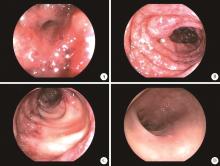Journal of Peking University (Health Sciences) ›› 2024, Vol. 56 ›› Issue (2): 362-365. doi: 10.19723/j.issn.1671-167X.2024.02.026
Previous Articles Next Articles
A case of COVID-19 associated ischemic colitis
Xin LIU1,Xueying SHI2,Jun LI1,*( )
)
- 1. Department of Gastroenterology, Peking University Third Hospital, Beijing 100191, China
2. Department of Pathology, Peking University Third Hospital, Beijing 100191, China
CLC Number:
- R574.62
| 1 |
Krejčová I , Berková A , Kvasnicová L , et al. Ischemic colitis in a patient with severe COVID-19 pneumonia[J]. Case Rep Gastroenterol, 2022, 16 (2): 526- 534.
doi: 10.1159/000525840 |
| 2 |
Paul T , Joy AR , Alsoub HARS , et al. Case report: Ischemic colitis in severe COVID-19 pneumonia: An unforeseen gastrointestinal complication[J]. Am J Trop Med Hyg, 2021, 104 (1): 63- 65.
doi: 10.4269/ajtmh.20-1262 |
| 3 |
Alratrout H , Debroux E . Acute right-sided ischemic colitis in a COVID-19 patient: A case report and review of the literature[J]. J Med Case Rep, 2022, 16 (1): 135- 139.
doi: 10.1186/s13256-022-03276-z |
| 4 |
FitzGerald JF , Hernandez Iii LO . Ischemic colitis[J]. Clin Colon Rectal Surg, 2015, 28 (2): 93- 98.
doi: 10.1055/s-0035-1549099 |
| 5 |
Brandt LJ , Feuerstadt P , Longstreth GF , et al. ACG clinical guideline: epidemiology, risk factors, patterns of presentation, diagnosis, and management of colon ischemia (CI)[J]. Am J Gastroenterol, 2015, 110 (1): 18- 44.
doi: 10.1038/ajg.2014.395 |
| 6 |
Washington C , Carmichael JC . Management of ischemic colitis[J]. Clin Colon Rectal Surg, 2012, 25 (4): 228- 235.
doi: 10.1055/s-0032-1329534 |
| 7 |
Pan L , Mu M , Yang P , et al. Clinical characteristics of COVID-19 patients with digestive symptoms in Hubei, China: A descriptive, cross-sectional, multicenter study[J]. Am J Gastroenterol, 2020, 115 (5): 766- 773.
doi: 10.14309/ajg.0000000000000620 |
| 8 |
Beyerstedt S , Casaro EB , Rangel ÉB . COVID-19: Angiotensin-converting enzyme 2 (ACE2) expression and tissue susceptibility to SARS-CoV-2 infection[J]. Eur J Clin Microbiol Infect Dis, 2021, 40 (5): 905- 919.
doi: 10.1007/s10096-020-04138-6 |
| 9 |
Xiao F , Tang M , Zheng X , et al. Evidence for gastrointestinal infection of SARS-CoV-2[J]. Gastroenterology, 2020, 158 (6): 1831- 1833.
doi: 10.1053/j.gastro.2020.02.055 |
| 10 |
Wu X , Jing H , Wang C , et al. Intestinal damage in COVID-19: SARS-CoV-2 infection and intestinal thrombosis[J]. Front Microbiol, 2022, 13, 860931.
doi: 10.3389/fmicb.2022.860931 |
| 11 |
Tang N , Li D , Wang X , et al. Abnormal coagulation parameters are associated with poor prognosis in patients with novel corona-virus pneumonia[J]. J Thromb Haemost, 2020, 18 (4): 844- 847.
doi: 10.1111/jth.14768 |
| 12 |
Panigada M , Bottino N , Tagliabue P , et al. Hypercoagulability of COVID-19 patients in intensive care unit: A report of thromboelastography findings and other parameters of hemostasis[J]. J Thromb Haemost, 2020, 18 (7): 1738- 1742.
doi: 10.1111/jth.14850 |
| 13 |
Zhang ML , Jacobsen F , Pepe-Mooney BJ , et al. Clinicopathological findings in patients with COVID-19-associated ischaemic enterocolitis[J]. Histopathology, 2021, 79 (6): 1004- 1017.
doi: 10.1111/his.14457 |
| 14 |
Revzin MV , Raza S , Srivastava NC , et al. Multisystem imaging manifestations of COVID-19, Part 2: From cardiac complications to pediatric manifestations[J]. Radiographics, 2020, 40 (7): 1866- 1892.
doi: 10.1148/rg.2020200195 |
| [1] | Jinrong ZHU,Yana ZHAO,Wei HUANG,Weiwei ZHAO,Yue WANG,Song WANG,Chunyan SU. Clinical characteristics of COVID-19 infection in patients undergoing hemodialysis [J]. Journal of Peking University (Health Sciences), 2024, 56(2): 267-272. |
| [2] | Jian-bin LI,Meng-na LYU,Qiang CHI,Yi-lin PENG,Peng-cheng LIU,Rui WU. Early prediction of severe COVID-19 in patients with Sjögren’s syndrome [J]. Journal of Peking University (Health Sciences), 2023, 55(6): 1007-1012. |
| [3] | Jin-hui LAI,Qi WANG,Jia-xiang JI,Ming-rui WANG,Xin-wei TANG,Ke-xin XU,Tao XU,Hao HU. Effects of delayed ureteral stents removal during the COVID-19 pandemic on the quality of life and psychological status of postoperative patients with urinary calculi [J]. Journal of Peking University (Health Sciences), 2023, 55(5): 857-864. |
| [4] | Zhi-yu KANG,Lei-lei WANG,Yong-zheng HAN,Xiang-yang GUO. Anesthesia management of athletes' operation in Beijing Olympic Winter Games [J]. Journal of Peking University (Health Sciences), 2022, 54(4): 770-773. |
| [5] | Ming-long CHEN,Xiao-han LIU,jing GUO. Relationship between social support and parental burnout in COVID-19 among Chinese young parents [J]. Journal of Peking University (Health Sciences), 2022, 54(3): 520-525. |
| [6] | Hong MENG,Li-na JI,Jing HUANG,Shuang CHAO,Jia-wen ZHOU,Xue-jun LI,Xiao-mei YIN,Li-rong FAN. Analysis of the changes and characteristics of pediatric outpatient visits in a general hospital in Beijing before and after the COVID-19 pandemic [J]. Journal of Peking University (Health Sciences), 2021, 53(5): 952-956. |
| [7] | HUANG Bing, WANG Hong-yuan. Analysis of the development trend and severity of the COVID-19 panidemic in the global world [J]. Journal of Peking University (Health Sciences), 2021, 53(3): 536-542. |
| [8] | Qiu WANG,Jin-yu GUO,Hong SUN,Ling WANG,Ju-su YING,Hui-xin LIU. Investigation of protective exposure risk events in nurses against corona virus disease 2019 in Wuhan [J]. Journal of Peking University (Health Sciences), 2020, 52(4): 711-714. |
| [9] | Mei-lian CHEN,Yan GAO,Wei GUO,Li ZUO,Tian-bing WANG. Infection prevention and control of bedside blood purification treatment in patients with COVID-19 [J]. Journal of Peking University (Health Sciences), 2020, 52(3): 414-419. |
| [10] | Hang YANG,Lin-cheng YANG,Rui-tao ZHANG,Yun-peng LING,Qing-gang GE. Risks factors for death among COVID-19 patients combined with hypertension, coronary heart disease or diabetes [J]. Journal of Peking University (Health Sciences), 2020, 52(3): 420-424. |
| [11] | Wen FENG,Liang-nan ZHANG,Jing-yuan LI,Tian WEI,Ting-ting PENG,Dong-xu ZHANG,Zai-xin GUO,Wei-song WANG. Analysis of special ehealth service for corona virus disease 2019 (COVID-19) pneumonia [J]. Journal of Peking University (Health Sciences), 2020, 52(2): 302-307. |
|
||



